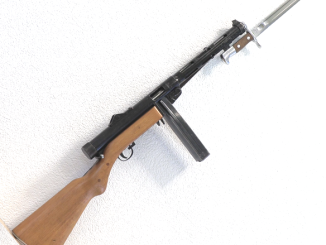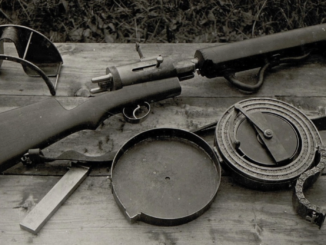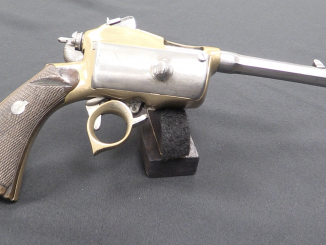The Swiss were the first country to adopt a bolt action repeating rifle with their Vetterli, and followed this by changing to a straight-pull design in the 1880s. The straight-pull Schmidt-Rubin system was quite good, but one potential flaw was that it was a quite long action. This became an issue when the Swiss began looking for a short cavalry carbine variant to use, and decided that the Schmidt-Rubin action sacrificed too much potential barrel length in a short rifle.
Instead, a series of trials were held to choose a different action for the Swiss cavalry carbine, and many different companies and factories submitted designs. The winner was the Mannlicher straight-pull system, best recognized in the US today by the Austrian Steyr M95. The Swiss adopted a carbine with that exact Mannlicher bolt design as the Model 1893 – it used the same basic motion as the Schmidt-Rubin rifles but was a much more compact action.
Unfortunately, the carbines did not prove a good match for the Swiss service. Swiss troops found them to be overly complex to disassemble and insufficiently accurate (presumably they had been spoiled by the excellent performance of domestic Swiss rifles). As a result, only 8000 of the Model 1893 were purchased, and the design was deemed obsolete in 1905 and replaced by a Schmidt-Rubin design after all (these 1905 carbines are virtually nonexistent today, as almost all were modified to the later 1911 pattern).
However, the 1893 stands out as probably the highest-quality Mannlicher straight pull rifles ever made.




Hello –
After they were withdrawn from service, many passed into private ownership. I have one that was converted in Switzerland into a sporting rifle. The barrel was bored out and re-rifled to 9.3mm, and the original rear sight replaced with a nicely made two-leaf open sight. A pistol-grip was mitered into the original stock, the seam being concealed nicely by checkering. All in all, a very light, handy and presumably potent rifle. It came with two boxes of 9.3×53 cartridges manufactured by Altdorf.
How it ended up in a hole-in-the-wall gun shop in way northern Wisconsin, I have no idea.
“9.3×53 cartridges manufactured by Altdorf”
Apparently two different cartridge under this designation exist:
http://www.municion.org/9_3/9_3x53M89B.htm
notice the bullet diameter to neck diameter radio
Newer version has bigger neck diameter and shorter shoulder:
http://www.municion.org/9_3/9_3x53Swiss.htm
Semi-smokeless ammunition. I’ve seen references to “semi-smokeless powder” elsewhere, but have been unable to find details on it. Does anyone have a clue what it is?
Semi-smokeless gunpowder came in two persuasions, to everyone’s confusion.
The first type was simply black powder made without any sulfur or very little sulfur (less than 5%). The purpose of sulfur in black powder is to ignite first when sparked at 241 degrees C, then rapidly combust raising the burning temperature to 370 C, the ignition/fusion point of potassium nitrate (saltpeter). This was necessary when powder ignition was by “match”, tinder, flintlock, etc.
Most percussion ignition systems generated temperatures at or above 370C without any help. As such, eliminating sulfur from the powder mixture was possible, and had several advantages, the most obvious being reduced smoke.
The smoke from black powder is mainly sulfur plus some carbon; most carbon residue is solid, and you’ll find it in the bore, binding to the nitrate residue from the saltpeter, which is strongly hygroscopic, produces acidic compounds in concert with some sulfur residues, and is what causes the bore to rust if you don’t clean it soon and thoroughly.
Another type of “semi-smokeless” powder is smokeless powder with about 5% sulfur added. Again, this was to reduce ignition temperature because some early smokeless powders only ignited at temperatures above 400C. The sulfur performed the same function here as it did in regular black powder.
King’s Semi-Smokeless was a popular early brand of this type of “semi-smokeless” powder, intended for use in shotgun shells. It was a high-bulk relative to power powder that could be loaded more or less weight-per-weight instead of black powder to achieve the same breech pressures and thus velocities with equal projectile weights.
Technically, modern-day Pyrodex shares many attributes of such “semi-smokeless” powders, but its chemical composition (which is patented and not in the public domain AFAIK) is substantially different.
cheers
eon
Semi-smokeless powders were made of partially nitrated wood (sawmeal or sawdust). Wood particles unlike cotton cannot be nitrated completely, only the surface. Also burn rate could not be really controlled. So you find semi-smokeless powder only in fast-burning applications like shotgun cartridges. Schultze powder is an example.
If you are ready to download some really big files, go to http://www.dtic.mil and search for “encyclopedia of explosives”. Its made up of 10 really large volumes and will answer all your questions if you are willing to take some time.
“go to http://www.dtic.mil and search for ‘encyclopedia of explosives’.”
Thanks for sharing that! Just quickly skimmed through the first volume so far, but that looks some interesting rainy-day reading.
There is guy at full30.com, probably Swiss, who says that the Swiss powder used for the cartridges was actually fully smokeless and the “semi-smokeless” attribute is just a mistranslation from Swiss-German “raucharm” (smoke-poor), which actually meant the same thing as “rauchfrei” (smokeless) in Germany. He said that he will try to fire one of his original cartridges and make a video of it.
http://www.chuckhawks.com/blackpowder_pyrodex.htm
says that semi-smokeless is combinations of blackpowder and nitrocellulose
and that from user point of view They produced much more smoke and fouling than today’s modern smokeless loads; the fouling was substantially less than blackpowder
“Mannlicher”
Ritter von Mannlicher designed various weapons, including many self-loading, for overview see:
http://www.cruffler.com/trivia-August00.html
Also, when reading von Mannlicher biographic entry:
http://www.austro-hungarian-army.co.uk/biog/mannlicher.htm
I found interesting that before arms invention he was employed at railroad (Kaiser-Ferdinand-Nordbahngesellschaft) to be precise as engineer, which is a bit similar case as Mikhail T. Kalashnikov which before arms-inventing worked at Турксиб (Turkestan–Siberia Railway).
The interpretation of word “Engineer” in common English is multiplex of which one is the a person “operating steam engine/ locomotive”. I do not believe this was the original occupation of von Mannlicher. He was already (again it common NA terms)”professional engineer” when he started to work for Southern Austrian Railways.
https://en.wikipedia.org/wiki/Ferdinand_Mannlicher
I do not believe M.T.K. ever achieved academic title of “professional engineer” other than perhaps as an honorary title.
This having said, it is on record that very few of “gun designers” were truly professional engineers by virtue of study, starting with J.M.B who himself was self-thought mechanic.
Certainly, when comes to artillery, engineering skills are unavoidable; but that is different category.
I should write that Mannlicher worked as Ingenieur.
“M.T.K. ever achieved academic title of “professional engineer” other than perhaps as an honorary title”
Mikhail T. Kalashnikov got title of доктор технических наук in 1971.
Looks like the barrel band is backwards. front ‘swivel’ should be on the left.
John Moses Browning’s father was a gunsmith, so he wasn’t purely self-taught; rather the profession ran in the family.
I also heard story that J.M.Browning never himself created blueprints of his weapons, but I don’t whatever it is true or not.
“John Moses Browning’s father was a gunsmith”
Vasily A. Degtyaryov in his memoirs (Моя жизнь, Воениздат, 1951) wrote that his granddad was blacksmith and he spend a lot of time in forge and he was inspired by inventor Kulibin – https://en.wikipedia.org/wiki/Ivan_Kulibin – which according to Degtyaryov was son of common soldier, but become well-known person.
Considering that the modern Swiss Army is composed of militiamen and not professional soldiers, it is best not to procure rifles with tons of complicated parts! There’s a reason the Galil rifle replaced the FAL in Israeli service-the latter was prone to jamming in sand and required lots of maintenance!
Given a choice as part of a security contractor group, how would you advise arming a local militia against sky pirates (zeppelins and all)? We’ve managed to open up the old armory in town. Also, try not to break the budget…
1. Gasser M1870 revolver
2. Suppressed Beretta M1934
3. Ithaca 37 trench gun with bayonet
4. Colt Burgess in .45 Colt or Colt Lightning in .357 Magnum
5. Mauser Model 1891
6. Mle 1918 RSC or Remington Model 8
7. Hotchkiss model 1914 heavy machine gun
8. STG-44 (how did this get here!?)
9. Or per the usual, screw the budget and add your favorite toys to this list
This activity is completely voluntary. You are not required to participate. Please keep any and all criticism of this post humane and free of foul language.
Thank you,
Cherndog
“against sky pirates”
Then you need AA artillery.
“arming a local militia”
I would advise long-arms over handguns, why? Because it is easier to learn shooting effectively from first and I would except that more militia-men have experience with long-arm than handguns, especially if hunting is popular in this area.
I suppose that the Scotti 20 mm cannon ought to be an effective deterrent against the pirates. Either that or we’ll roll out the halftrack mounted Flak 18.
“Scotti 20 mm cannon”
According to http://www.firstworldwar.com/airwar/bombers_zeppelins.htm
The German military was becoming disillusioned with the Zeppelins, and began using the new Gotha and Giant bombers to attack Britain, but Strasser remained convinced. The answer was to fly higher, above the defending aircraft. Thus was conceived the third generation of Zeppelins, the “Height Climbers”, airships capable of reaching an altitude of 20,000 feet.
So 20mm Scotti has to low vertical range – enemy can fly above, you need AA gun with more range.
That’s why I specifically got out the 8.8 cm Flak cannon halftrack. It’s maximum ceiling is 8000 meters, which is more than enough to get those high altitude Zeppelin bombers. And besides, the pirates would prefer not to blow up your neighborhood before they took your goodies unless they found that the victims had nasty tricks up their sleeves. In which case you’d best be sure no pirate lives long enough to tell his mates that you’ve got a huge flak cannon waiting for their airship.